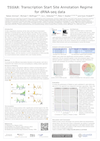TSSAR: Transcription Start Site Annotation Regime Web Service
Overview
The TSSAR Web Service consists of three major parts which gear into each other. The first step in a TSSAR analysis of dRNA-seq data is pre-processing with the platform-independent TSSAR Client. This program extracts the relevant information from your mapped sequencing reads and transmits them to the TSSAR Server. The Web Server then applies the appropriate analysis steps, among them the TSSAR Statistical Model, to your data. Eventually, you will be notified by email (if an email address has been supplied during data submission) once the computation is finished.
Below, please find for each of the steps a short introduction how to use it. You might want to start with TSSAR Java Client. For a quick start please visit the TSSAR Workflow page.

"TSSAR: TSS Annotation Regime for dRNA-seq data" F. Amman, M.T. Wolfinger, R. Lorenz, I.L. Hofacker, P.F. Stadler and S. Findeiß - BMC Bioinformatics, 2014 15:89 doi:10.1186/1471-2105-15-89
Presented at the 3rd International Conference on Regulating with RNA in Bacteria, Würzburg - Germany (2013). Download as [PDF]




